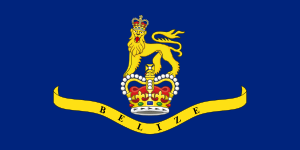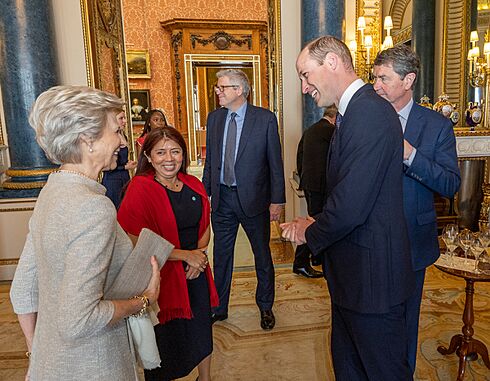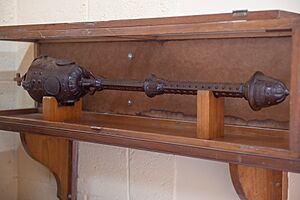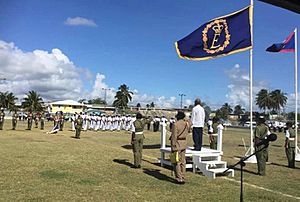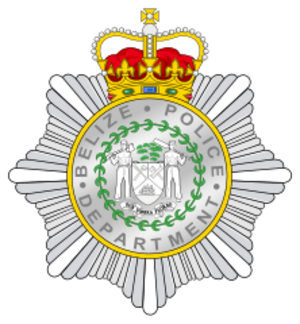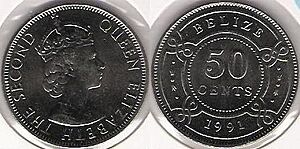Monarchy of Belize facts for kids
Quick facts for kids King of Belize |
|
|---|---|
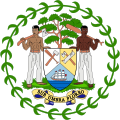
|
|
| Incumbent | |
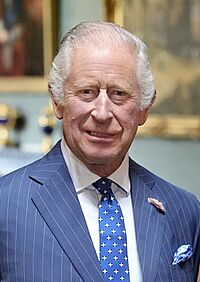 |
|
| Charles III since 8 September 2022 |
|
| Details | |
| Style | His Majesty |
| Heir apparent | William, Prince of Wales |
| First monarch | Elizabeth II |
| Formation | 21 September 1981 |
The monarchy of Belize is a system of government where a monarch (a king or queen) is the official head of state. This role is passed down through generations in the royal family. Since September 8, 2022, King Charles III has been the monarch of Belize. He represents the "Belizean Crown," which is like the legal idea of the country itself.
Even though King Charles III is also the monarch for 14 other independent countries in the Commonwealth of Nations, Belize's monarchy is completely separate. This means he is officially called the King of Belize. He and other members of the royal family do public and private duties for Belize. However, only the King has a real role in Belize's laws.
The King holds all the main power in Belize, but most of it is used by elected members of parliament, government ministers, and judges. The King's approval, called royal assent, is needed for new laws to start. Other powers the King has are important but are mostly used only in special situations.
Today, the Crown helps make sure the government runs smoothly and fairly. It also acts as a neutral protector against anyone trying to misuse power. While the King has some special duties, most of his daily and ceremonial tasks are done by his representative in Belize, the Governor-General.
Contents
How the Monarchy Started in Belize
In 1836, after countries in Central America became free from Spanish rule, the British said they had the right to control the area now known as Belize. In 1862, this area, called the Settlement of Belize in the Bay of Honduras, became a British colony named British Honduras. The Queen's representative there was called a lieutenant governor, who reported to the governor of Jamaica.
In 1964, British Honduras got the right to govern itself under a new set of rules. On June 1, 1973, British Honduras officially changed its name to Belize. Belize became fully independent from the United Kingdom on September 21, 1981. This happened after Queen Elizabeth II signed the Belize Independence Order. This made Belize a sovereign country and a constitutional monarchy, meaning it has a monarch but also a constitution that limits their power.
Prince Michael of Kent came to Belize for the independence celebrations. On the morning of September 21, in the capital city of Belmopan, he gave the official independence documents to George Cadle Price, who became Belize's first prime minister. On the same day, Elmira Minita Gordon, a sociologist, was chosen by the Queen to be the Governor-General of Belize. She was the first woman to hold this position in any Commonwealth country.
The Crown of Belize: What It Means
Belize shares its monarch with 14 other Commonwealth realms. These are countries in the Commonwealth of Nations that all have the same person as their head of state. However, the King's role in Belize is completely separate from his role as monarch of any other country. Even though they share the same person as monarch, each Commonwealth realm is independent.
Since Belize became independent in 1981, the Belizean Crown has been both shared and unique. The King's role as monarch of Belize is different from his role as monarch of any other country, including the United Kingdom. Only Belizean ministers can give advice to the King about matters concerning Belize. This means the monarchy is no longer just a British thing; in Belize, it has become a "Belizean" institution.
This difference is shown in several ways. For example, the King has a special Belizean title. When he acts publicly as a representative of Belize, he uses Belizean symbols, like the country's national flag.
In Belize, the legal term for the country's government is the "Crown in Right of Belize." This means "His Majesty acting for His Government in Belize."
The King's Title
In Belize, the King's full official title is: Charles the Third, by the Grace of God, King of Belize and of His Other Realms and Territories, Head of the Commonwealth.
This long title shows that Belize is an independent monarchy. It highlights the King's specific role as the King of Belize. Usually, he is just called "King of Belize" when he is in the country.
Who Becomes King or Queen Next?
|
William, Prince of Wales, who will be the next King of Belize, with Governor-General Dame Froyla Tzalam, in 2023.
|
Belize follows the United Kingdom's laws to decide who will be the next King or Queen.
The rules for who inherits the throne are based on primogeniture, which means the oldest child, regardless of gender, inherits. These rules come from laws like the Succession to the Crown Act 2013. They state that only natural, legitimate descendants of Sophia of Hanover can become monarch. Also, the monarch cannot be a Roman Catholic and must be part of the Church of England. Even though these laws are controlled by the British parliament, neither the UK nor Belize can change them without all the other Commonwealth realms agreeing.
When a monarch dies or steps down, the new monarch automatically takes the throne right away. There is no need for a special ceremony to confirm it. After a monarch passes away, there is a period of mourning, and flags across the country are flown at half-mast. The day of the funeral is often a public holiday. A special service to remember the late monarch is usually held at St. John's Cathedral in Belize City.
The King's Role in Government
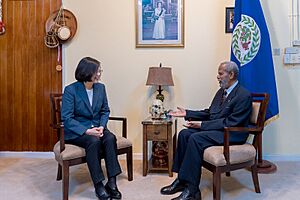
The Belizean Constitution sets up a government system similar to other Commonwealth countries. All the government's powers are officially held by the monarch. The monarch is represented in Belize by the Governor-General, who is chosen by the King based on the advice of the prime minister of Belize. The Governor-General handles the King's duties within Belize.
The role of the King and the Governor-General is both legal and practical. The Crown is seen as a central part of the country's legal structure, with the monarch at its heart.
Running the Government
The Governor-General chooses the prime minister, who then leads the Cabinet. The Cabinet advises the King or Governor-General on how to use their powers for all government and foreign matters. The King is kept informed by the Governor-General when a prime minister resigns and when a new prime minister and ministers are sworn in.
The Governor-General also appoints and removes ministers, members of government agencies, and other officials.
A few duties must be done specifically by the King, such as signing the official papers for Governor-Generals.
Since all of Belize's executive power belongs to the King, government bodies are said to act under his authority. This is why the government of Belize is formally called "His Majesty's Government in Belize."
Dealing with Other Countries
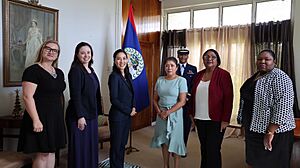
The King's special powers also include foreign affairs. The King or the Governor-General can make and sign treaties, alliances, and international agreements. Parliament does not need to approve these. However, a treaty cannot change Belize's local laws; a special Act of Parliament is needed for that. The Governor-General, acting for the King, also officially welcomes ambassadors from other countries and sends Belizean ambassadors abroad.
Also, Belizean passports are issued under the King's authority, in the Governor-General's name.
The National Assembly
The Governor-General is responsible for calling together the two parts of the National Assembly: the Senate and the House of Representatives. The Governor-General can also pause or end a parliamentary session at any time. At the start of a new session, the Governor-General reads the Speech from the Throne, which explains the government's plans for new laws. After a session ends, a general election is held, and the Governor-General issues the official orders for it.
The constitution also says that the Governor-General alone appoints senators. The Governor-General must appoint five senators based on the prime minister's advice, one after talking with the Belize Advisory Council, and two based on the advice of the leader of the opposition.
All laws in Belize become official with the Governor-General's signature. This signing is called Royal Assent. It is needed for all acts of parliament and is usually given or withheld by the Governor-General, using the Public Seal of Belize.
The authority of the Crown is shown in the mace of the House of Representatives, which has a crown at its top.
Because Belize has a constitutional monarchy, the King's powers are almost always used based on the advice of his prime minister and other ministers. These ministers are responsible to the elected House of Representatives and, through them, to the people. The King's role, and therefore the Governor-General's role, is mostly symbolic. They represent the legal authority under which all governments operate. However, in very rare cases, the King or Governor-General can act against this advice using their special "reserve powers."
The Courts
The King is responsible for making sure justice is served to everyone. He is traditionally seen as the "source of justice." In Belize, crimes are legally considered offenses against the King. Lawsuits for serious crimes are brought in the King's name, for example, "The King versus [Name]." This means the King cannot be charged with crimes in his own courts.
The Governor-General also appoints the chief justice of Belize and other judges of the Supreme Court, acting on behalf of the King.
The Governor-General can also grant protection from prosecution, use the "prerogative of mercy," and pardon people who have committed crimes against the Crown. Pardons can be given before, during, or after a trial. The power to grant pardons and reduce prison sentences is described in section 52 of the Belizean Constitution.
Cultural Role of the Monarchy
Belize celebrates the King's birthday every year in May. This day is called Sovereign's Day. It is marked by parades in Belize City, though it is not a public holiday like in the UK. Horse races are held in Belize City and Orange Walk Town. A cycling race also takes place between Belmopan and Cayo. Schools and universities hold flag-raising ceremonies and other events to celebrate Sovereign's Day.
Awards and Honours
The monarch is seen as the "source of honour." In Belize, the King gives out awards and honours in his name. Most of these are given based on the advice of "His Majesty's Belize Ministers." The Governor-General presents these awards on behalf of the King.
In 1991, Belize created three national awards: the Order of Belize, the Order of Distinction, and the Order of the National Hero. The Governor-General is the head of all these awards.
The Crown and the Defence Force
The Crown is at the very top of the Belize Defence Force. The King is the Commander-in-Chief of all the forces. The Crown of St. Edward appears on the badges and rank symbols of the Belize Defence Force. This shows that the monarchy is the source of authority.
Under Belize's Defence Act, every member of the Belize Defence Force must promise loyalty to the King of Belize when they join. The oath they take is:
"I, (name), do sincerely promise and swear that I will be faithful and bear true allegiance to Our Sovereign Lord the King and to His constitutionally Elected Government in Belize and that I will faithfully serve His Majesty in the Belize Defence Force until lawfully discharged, dismissed or removed, and that I will resist His Majesty's enemies and defend and protect all His Majesty's subjects and territory in Belize and cause His Majesty's peace to be kept and maintained and that I will in all matters appertaining to my service faithfully discharge my duties according to law."
The Crown and the Police Force
Every member of the Belize Police Department must also promise loyalty to the King of Belize when they join. Under the Police Act of Belize, every police officer must make this declaration:
"I, (name), do solemnly and sincerely declare that I will be faithful and bear true allegiance to His Majesty, King Charles the Third, His Heirs and Successors, and that I will faithfully serve His Majesty the King, His Heirs and Successors, during my service in the Department and will obey all orders of the Governor-General and of the officers placed over me, and will subject myself to all Acts, Orders and Regulations, from time to time in force, relating to the Department."
All official announcements to control riots are also made in the King's name and end with "God Save the King."
The St Edward's Crown is used on the badge of the Belize Police Department. It is also part of the rank symbols for high-ranking officers like the commissioner and superintendents.
Royal Symbols
The main symbol of the Belizean monarchy is the King himself. Pictures of him are displayed in public buildings and government offices. Many Belizeans also have pictures of the royal family in their homes. Queen Elizabeth II appeared on some special Belizean stamps. Her crowned image is clearly shown on Belizean coins. All Belize dollar banknotes featured the Queen's picture until new ones were introduced in 2025.
A crown is also used to show that the monarchy is the source of authority. It appears on badges and rank symbols for the police force, postal workers, prison officers, and the Belize Defence Force.
God Save the King is the royal anthem of Belize.
When new people become Belizean citizens, they must take an Oath of Citizenship to promise loyalty to the King of Belize and his future heirs.
Royal Visits to Belize
20th Century Visits
Princess Margaret visited Belize in 1958. The Duke of Edinburgh visited in 1962. Prince Michael of Kent represented the Queen at the independence celebrations in September 1981.
Queen Elizabeth II, the Queen of Belize, visited the country in October 1985. The mayor welcomed her and gave her the key to Belize City. She stayed at Government House before flying to Dangriga the next day. There, she watched a Junkanoo Dance by children and received a painting. She also met British soldiers stationed in Belize. During her visit, the Queen was served the famous gibnut at an official dinner. The next day, British newspapers in London had headlines like "Queen Eats Rat in Belize." Since then, the gibnut has often been called "The Royal Rat" or "The Queen's Rat" in Belize.
The Duke of Edinburgh returned in 1988 for a visit on his own, as President of the World Wide Fund for Nature.
The Queen visited again in 1994. When she arrived at the airport in Belize City, about 90% of the city's population greeted her. The Queen also visited the towns of San Ignacio, Punta Gorda, and Cahal Pech, which is an ancient Mayan site. The Queen attended a special meeting of the National Assembly, where she spoke for the first time. She talked about Belize's "strong democracy." The Queen also noted that this was the first time she had been welcomed by a song written and performed by a Governor-General.
21st Century Visits
The Princess Royal visited Belize in April 2001. She visited the National Assembly in Belmopan and the Belize Defence Force barracks. During her visit, the Princess also went to a primary school, a Mennonite community, a conservation area, a children's home, the Belize Zoo, and a war cemetery.
In 2012, Prince Harry visited on behalf of the Queen to celebrate her Diamond Jubilee (60 years on the throne). During his visit, Prince Harry saw the ancient Mayan city of Xunantunich, launched a canoe named after the Queen, and attended the official naming of 'Her Majesty Queen Elizabeth II Boulevard' in Belmopan.
The Duke and Duchess of Cambridge visited in March 2022 for the Queen's Platinum Jubilee (70 years on the throne). During their visit, they explored Mayan sites, learned about Maya chocolate making, and celebrated the culture of the Garifuna community. The Duke and Duchess also learned about efforts to restore Belize's barrier reef and even went scuba diving to see the world's second-largest barrier reef up close. At a party hosted by Governor-General Dame Froyla Tzalam, the Duke said, "Now we know why Belize is so lovingly referred to as the Jewel. We hope to return again soon and to show our children this wonderful country. They are rather jealous that they're not here with us now." A planned visit to a Maya village was canceled due to local protests.
Discussions About the Monarchy
In March 2022, the government of Belize created the People's Constitutional Commission. This group is reviewing Belize's laws, including the constitution, and how the country is governed. Prime Minister Johnny Briceño has said he will hold a public vote (referendum) on the commission's suggestions, which are expected in 2024.
In May 2023, Prime Minister Briceño suggested it was "quite likely" that Belize would be the next Commonwealth country to become a republic. A republic is a country where the head of state is an elected president, not a monarch. Briceño did not say if he would propose a bill for a referendum on becoming a republic, which would need parliament's approval.
A survey done in February and March 2023 found that 48 percent of people supported keeping Belize's monarchy, while 43 percent wanted a republic. Seventy-one percent of those who wanted to keep the Crown said the monarchy was a "good thing" for the country.
List of Belizean Monarchs
| Portrait | Name of Monarch (Born–Died) |
Time as Monarch of Belize | Full Name | Spouse | Royal Family | |
|---|---|---|---|---|---|---|
| Start | End | |||||
 |
Elizabeth II (1926–2022) |
21 September 1981 | 8 September 2022 | Elizabeth Alexandra Mary | Philip Mountbatten | Windsor |
| Governors-General: Dame Elmira Minita Gordon, Sir Colville Young, Dame Froyla Tzalam Prime Ministers: George Cadle Price, Sir Manuel Esquivel, Said Musa, Dean Barrow, Johnny Briceño |
||||||
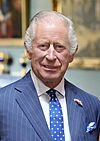 |
Charles III (b. 1948) |
8 September 2022 | present | Charles Phillip Arthur George | Camilla Shand | Windsor |
| Governors-General: Dame Froyla Tzalam Prime Ministers: Johnny Briceño |
||||||
See also
- Lists of office-holders
- Monarchies in the Americas
- List of monarchies


